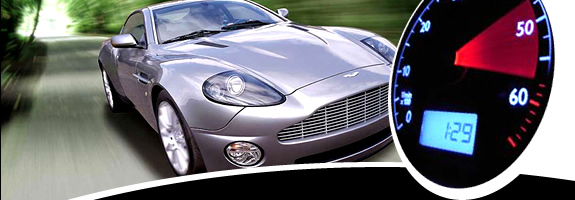

About Aston Martin |
|
Aston Martin Lagonda Ltd. is a British luxury car manufacturer based in Newport Pagnell, Buckinghamshire. Up to the year 2003, approximately 20,200 cars had been built by Aston Martin. Today, the company is part of the Premier Automotive Group division of Ford Motor Company. Aston Martin was founded in 1914 by Lionel Martin and Robert Bamford. The two had joined forces the previous year to sell cars made by Singer. Martin raced specials at the Aston Hill Hillclimb near Aston Clinton, and the pair decided to make their own vehicles. They acquired premises at Abingdon Road in Kensington and produced their first car in March 1915. The company name was derived from Aston Hill and Lionel Martin. After the war hiatus, the company was revitalised with funding from Count Louis Zborowski. In 1922, Aston Martin produced cars to compete in the French Grand Prix, and the cars set world speed and endurance records at Brooklands. Lionel Martin left in 1925; the following year, a number of rich investors, including Lord Charnwood, took control of the company as Aston Martin Motors, and moved the firm to new premises in Feltham. The 1929 Aston Martin International was another successful racer and was followed by the Le Mans and the Ulster. In 1936, the company, now owned by Sir Arthur Sutherland, decided to concentrate on road cars. The advent of World War II halted work, and the company languished throughout the war's duration. In 1947, David Brown Limited bought the company under the leadership of managing director Sir David Brown — its "post-war saviour". David Brown also acquired Lagonda that year, and both companies shared resources and workshops. In 1954, David Brown bought the site at Tickford Street in Newport Pagnell, and that was the beginning of the classic series of cars bearing the initials 'DB'. In 1950, the company announced the DB2, followed by the racing DB3 in 1957 and the Italian-styled 3.7 L DB4 in 1958. All the cars established a good racing pedigree for the firm, but the DB4 was the key to establishing the company's reputation—which was cemented with the famous DB5 in 1963. The company continued developing the "grand touring" style with the DB6 (1965–70, the DBS, and the DBS V8 (1967–72). The latter was subsequently renamed the Vantage. Despite the cars' appreciation in value, the company was often financially troubled. In 1972, it was sold to a Birmingham-based consortium, and resold in 1975 to the North American businessmen Peter Sprague and George Minden. The new American owners pushed the company into modernizing its line, producing the V8 Vantage in 1977, the convertible Volante in 1978, and the one-off William Towns-styled Bulldog in 1980. Towns also styled the futuristic new Lagonda saloon, based on the existing V8 model. The Americans sold the company to CH Industrial, who themselves turned the company over in 1983 to Automotive Investments who, in turn, lasted barely a year before selling the company to Peter Livanos and company chairman Victor Gauntlett. At last, in 1986, the Ford Motor Company purchased 75 per cent of the company, later gaining complete control of the company. In 1988, having produced some 5,000 cars in twenty years, the company finally retired the ancient V8 and introduced the Virage range. In 1992, the Vantage version was announced, and the following year the company renewed the DB range by announcing the DB7. In 1993, Ford finally bought Victor Gauntlett's shares and took full control of the firm, placing it in the Ford Premier Automotive Group. Ford substantially invested in new manufacturing and quickly ramped-up production. In 1994, Ford opened a new factory at Banbury Road in Bloxham. In 1995, the company produced a record 700 vehicles, in 1998 the 2,000th DB7 was built, and in 2002 the 6,000th — exceeding production of all previous DB models. The DB7 range was boosted by the addition of V12 Vantage models in 1999, and in 2001 the company introduced the V12-engine Vanquish. 2003 was a significant year for Aston Martin. At the North American International Auto Show in Detroit, Michigan, U.S.A., Aston Martin introduced the new AMV8 Vantage concept car. Expected to have few changes before its introduction in 2005, the new AMV8 Vantage brings back the classic V8 engine and will allow the company to compete in a larger market. The year also saw the opening of the Gaydon factory, the first purpose-built factory in Aston Martin's history. Also introduced in 2003, was the new DB9 coupé, which replaces the ten-year-old DB7. A convertible version of the DB9, known as the DB9 Volante, was introduced at the 2004 Detroit Auto Show. In December 2003, Aston Martin announced they would return to motor racing in 2005. A new division was created, called Aston Martin Racing, who will be responsible, together with Prodrive, for the design, development, and management of the DBR9 program. The DBR9 will compete in the GT class in sports car races including the world-famous 24 hours of Le Mans. |
© Copyright 2025, Astonmartindealers.net All rights reserved. Unauthorized duplication in part or whole strictly prohibited by international copyright law. |
|
|